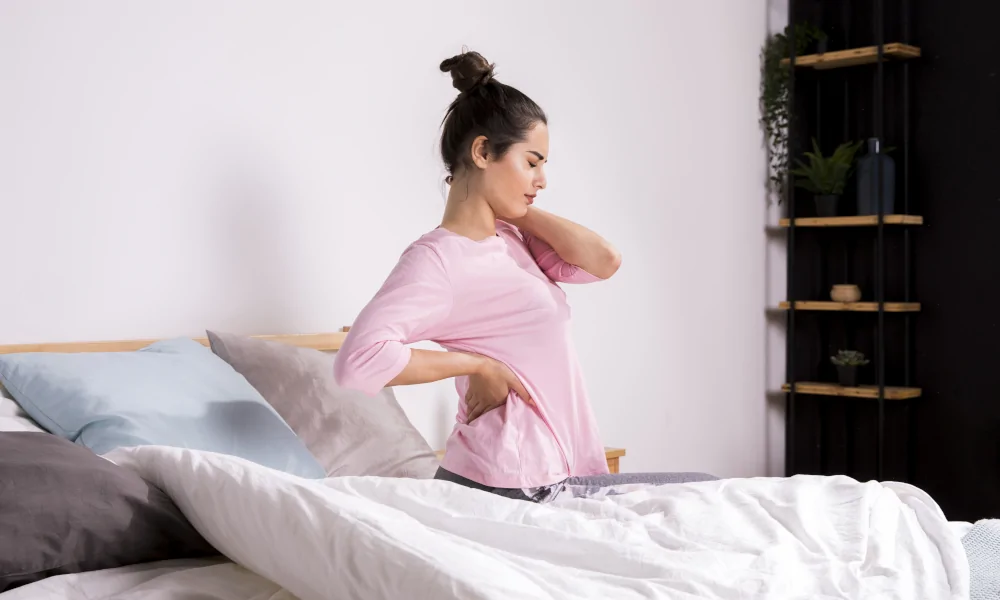Lower back pain is a common problem that affects millions of people worldwide, often disrupting sleep and overall well-being. In the UK, back pain is the leading cause of disability, with lower back pain alone responsible for 11% of the total disability in the population. Finding relief from this discomfort during sleep is essential for improving both rest quality and overall health. This article aims to provide practical solutions for alleviating lower back pain during sleep, focusing on optimal sleep positions, mattress selection, pillow choices, and additional factors contributing to pain relief.
Understanding lower back pain and sleep
Lower back pain, medically known as lumbago, is commonly characterised by discomfort in the lumbar region. It can result from various factors, including muscle strain, poor posture, herniated discs, or underlying medical conditions. Symptoms typically include dull aches, sharp pains, or stiffness in the lower back area.
The relationship between lower back pain and sleep is bidirectional. Pain can lead to sleep disturbances, such as difficulty falling asleep, frequent night awakenings, and reduced sleep quality. Conversely, poor sleep can exacerbate pain perception and hinder the body’s natural healing processes, creating a vicious cycle of discomfort and sleeplessness.
Sleep positions for lower back pain
Different sleep positions exert varying levels of stress on different muscle groups. While there’s no one-size-fits-all solution, certain positions may provide more relief for individuals with lower back pain. It’s important to note that the effectiveness of each position can vary from person to person, and finding the correct position often requires some experimentation.
Side sleeping
Different sleep positions have been used to comfort lower back pain. Side sleeping is often recommended for individuals with this condition due to several potential benefits.
Spinal alignment: When executed correctly, side sleeping can help to maintain proper spinal alignment, potentially reducing lower back stress.
Pressure relief: This position can alleviate pressure on the spine and surrounding muscles.
Adaptability: Side sleeping can be easily modified with pillow support to enhance comfort.
To maximise the benefits of side sleeping:
● Position a pillow between the knees to maintain alignment of the hips, pelvis, and spine.
● Utilise a supportive pillow under the head to ensure neutral neck positioning.
● Consider employing a body pillow for additional support and to prevent spinal misalignment caused by the upper arm.
However, side sleeping can come with challenges, such as shoulder pain or arm numbness on the side you’re sleeping on. It may also cause hip discomfort if not properly supported and increase the risk of facial wrinkles from prolonged pressure.
Back sleeping
Back sleeping is often considered the ideal position for maintaining spinal alignment and reducing lower back pain. Key advantages include:
Even weight distribution: This position spreads your body weight evenly, minimising pressure points.
Natural alignment: It allows your head, neck, and spine to rest in a neutral position.
Reduced acid reflux: For those who experience heartburn, back sleeping with the head slightly elevated may provide relief.
To optimise back sleeping for lower back pain relief, place a small pillow or rolled-up towel under your knees to maintain the spine’s natural curvature. Use a supportive pillow that keeps your head and neck aligned with your spine, and consider placing a thin pillow under your lower back for added support if there’s a gap between your back and the mattress.
However, back sleeping may not be suitable for everyone. It can worsen sleep apnoea and snoring in some individuals, and some may find it difficult to fall asleep in this position. Additionally, those with certain conditions, like severe GORD, may need to avoid lying flat on their back.
Stomach sleeping
Stomach sleeping is generally not recommended for individuals with back pain due to potential spinal misalignment, increased joint and muscle stress, and respiratory challenges. This position can force the neck into an unnatural twist and overarch the lower back, putting unnecessary pressure on the spine and making it harder to breathe freely.
However, if stomach sleeping is unavoidable, there are ways to mitigate its negative effects. Using a very thin pillow under the head (or no pillow at all) can minimise neck strain. Placing a slim pillow beneath the hips may help reduce lower back arching. Alternating the direction of head rotation can prevent one-sided neck stiffness.
The importance of a good mattress and pillow
The right mattress and pillow are crucial in managing lower back pain during sleep. A supportive sleep surface can help maintain proper spinal alignment and alleviate pressure points.
When choosing a mattress for lower back pain:
Firmness: Medium-firm mattresses often provide the best support and comfort for individuals with lower back pain. However, personal preference and body type should be considered.
Support: Look for a mattress that conforms to your body’s natural curves while providing adequate support.
Materials: Memory foam, latex, and high-quality innerspring mattresses all are suitable options. Each material has its own support, heat retention, and durability properties.
Pressure relief: Choose a mattress that distributes your body weight evenly to reduce pressure on the lower back.
Motion isolation: If you share a bed, consider a mattress with good motion isolation to prevent disturbances from a partner’s movements.
Selecting the right pillow is crucial for maintaining proper spinal alignment. Back sleepers should use a pillow that supports the natural curve of the neck without pushing the head forward, while side sleepers need a firmer, higher pillow to keep the head aligned with the spine. Stomach sleepers should opt for a very thin pillow or no pillow at all to minimise neck strain.
Additional tips for back pain relief
Managing lower back pain extends beyond sleep positions and bedding choices. Incorporating these additional strategies can significantly improve your overall back health and sleep quality.
Regular exercise: Engage in low-impact activities like walking, swimming, or yoga to strengthen core muscles and improve flexibility. Consult a physical therapist to develop a safe exercise routine tailored to your needs.
Weight management: Maintaining a healthy weight reduces stress on your lower back. It’s advisable to consult with a healthcare provider or nutritionist to develop a balanced diet and exercise.
Ergonomics: Pay attention to your posture during daily activities. Use ergonomic chairs and desks at work, and be mindful of your posture when using electronic devices.
Stretching: Incorporate gentle stretching exercises into your daily routine, especially before bed. Focus on stretches that target the lower back, hamstrings, and hip flexors.
Heat and cold therapy: Apply heat to relax tense muscles before bed, or use cold packs to reduce inflammation. Experiment to see which works better for you.
Stress management: Practice relaxation techniques such as deep breathing, meditation, or progressive muscle relaxation to reduce muscle tension and promote better sleep.
Consistent sleep schedule: Maintain a regular healthier sleep cycle to improve overall sleep quality and reduce pain perception.
Bedtime routine: Establish a calming pre-sleep routine to signal to your body that it’s time to wind down. This might include light reading, gentle stretching, or listening to soothing music.
It’s crucial to seek professional medical advice for persistent or severe lower back pain, especially if accompanied by symptoms like numbness, tingling, or weakness in the legs. A healthcare professional can provide an accurate diagnosis and recommend appropriate treatments, ensuring a comprehensive approach to back pain management.
Lower back pain keeping you awake?
Addressing lower back pain for better sleep involves a multifaceted approach. Finding the right sleep position, choosing appropriate mattresses and pillows, and implementing lifestyle changes can significantly improve your sleep quality and reduce lower back discomfort.
If you’re still struggling with sleep issues despite implementing these strategies, it may be time to seek expert help. As an experienced sleep specialist, we have successfully guided numerous individuals in overcoming their sleep challenges. Don’t let persistent sleep problems hinder your quality of life. Please contact us today for a personalised consultation or if you require any further advice and information.










